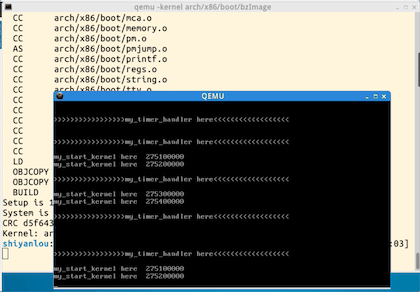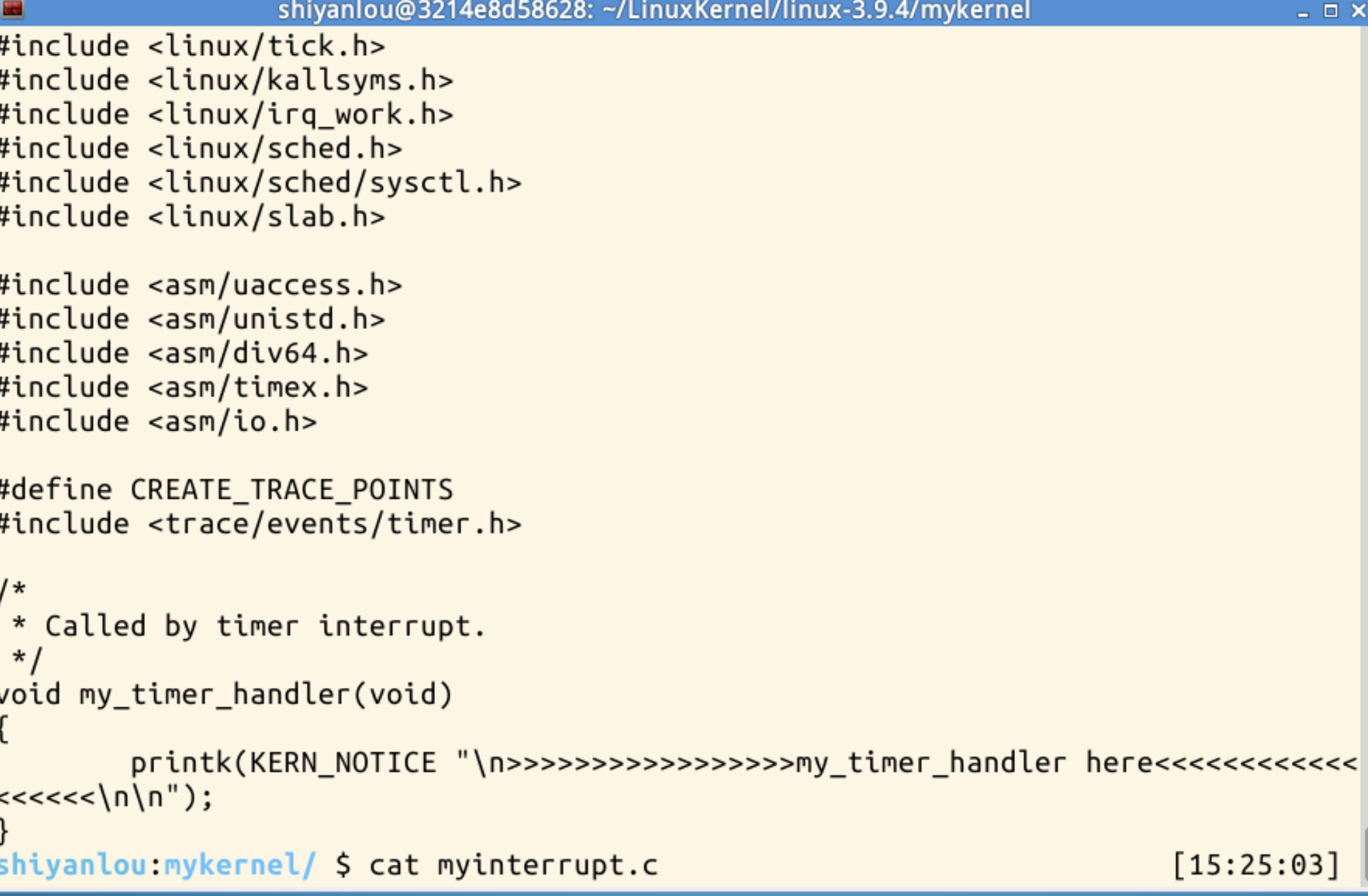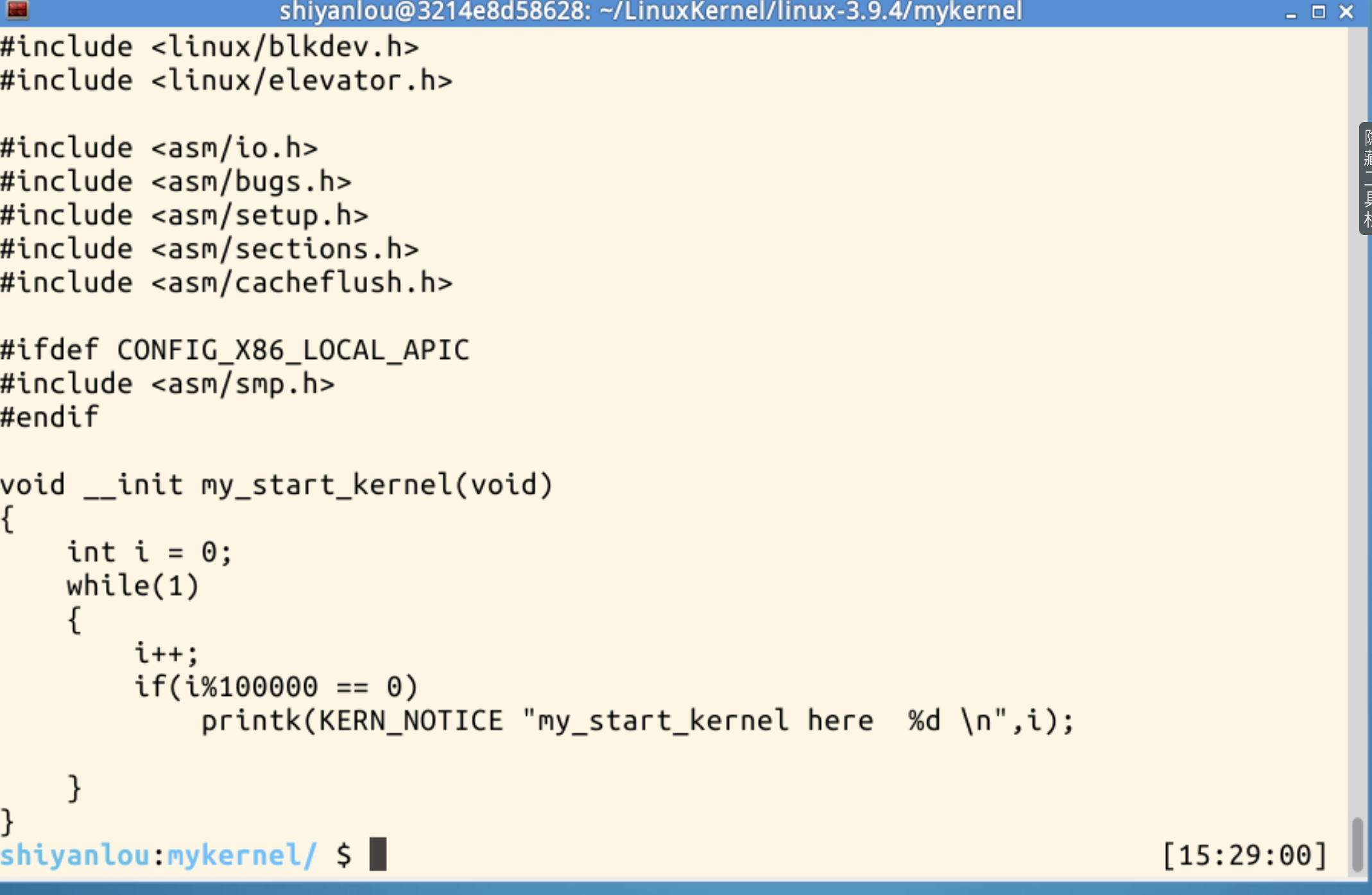浅析简单的时间片轮转多道程序内核代码
学号后三位<126>
原创作品转载请注明出处https://github.com/mengning/linuxkernel/
一、编译mykernel并使用qemu运行
1 cd LinuxKernel/linux-3.9.4 2 rm -rf mykernel 3 patch -p1 < ../mykernel_for_linux3.9.4sc.patch 4 make allnoconfig 5 make 6 qemu -kernel arch/x86/boot/bzImage

二、代码分析
关于 myinterrupt.c 和 mymain.c


由分析可知,qemu中交替出现的输出是有上面两个c文件输出的,也就是说通过修改输出内容就可以定制自己的输出了
关于mypcb.h
#define MAX_TASK_NUM 4 #define KERNEL_STACK_SIZE 1024*2 /* CPU-specific state of this task */ struct Thread { unsigned long ip; unsigned long sp; }; typedef struct PCB{ int pid; volatile long state; /* -1 unrunnable, 0 runnable, >0 stopped */ unsigned long stack[KERNEL_STACK_SIZE]; /* CPU-specific state of this task */ struct Thread thread; unsigned long task_entry; struct PCB *next; }tPCB;
Thread结构体中定义了一个储存指令位置和栈顶位置,PCB结构体中储存了进程id,状态,入口位置,下个PCB指纹等必要的信息
关于mymain.c
/* * linux/mykernel/mymain.c *
* Kernel internal my_start_kernel * * Copyright (C) 2013 Mengning * */ #include <linux/types.h> #include <linux/string.h> #include <linux/ctype.h> #include <linux/tty.h> #include <linux/vmalloc.h> #include "mypcb.h" tPCB task[MAX_TASK_NUM]; tPCB * my_current_task = NULL; volatile int my_need_sched = 0; void my_process(void); void __init my_start_kernel(void) { int pid = 0; int i; /* Initialize process 0*/ task[pid].pid = pid; task[pid].state = 0;/* -1 unrunnable, 0 runnable, >0 stopped */ task[pid].task_entry = task[pid].thread.ip = (unsigned long)my_process; task[pid].thread.sp = (unsigned long)&task[pid].stack[KERNEL_STACK_SIZE-1]; task[pid].next = &task[pid]; /*fork more process */ for(i=1;i<MAX_TASK_NUM;i++) { memcpy(&task[i],&task[0],sizeof(tPCB)); task[i].pid = i; //*(&task[i].stack[KERNEL_STACK_SIZE-1] - 1) = (unsigned long)&task[i].stack[KERNEL_STACK_SIZE-1]; task[i].thread.sp = (unsigned long)(&task[i].stack[KERNEL_STACK_SIZE-1]); task[i].next = task[i-1].next; task[i-1].next = &task[i]; } /* start process 0 by task[0] */ pid = 0; my_current_task = &task[pid]; asm volatile( "movl %1,%%esp\n\t" /* set task[pid].thread.sp to esp */ "pushl %1\n\t" /* push ebp */ "pushl %0\n\t" /* push task[pid].thread.ip */ "ret\n\t" /* pop task[pid].thread.ip to eip */ : : "c" (task[pid].thread.ip),"d" (task[pid].thread.sp) /* input c or d mean %ecx/%edx*/ ); } int i = 0; void my_process(void) { while(1) { i++; if(i%10000000 == 0) { printk(KERN_NOTICE "this is process %d -\n",my_current_task->pid); if(my_need_sched == 1) { my_need_sched = 0; my_schedule(); } printk(KERN_NOTICE "this is process %d +\n",my_current_task->pid); } } }
首先初始化了一个pid为0的进程,作为内核中的第一个进程, 操作系统在初始化时只有一个0号进程,之后的所有进程都由该进程fork而来
关于myinterrupt.c
/* * linux/mykernel/myinterrupt.c * * Kernel internal my_timer_handler * * Copyright (C) 2013 Mengning * */ #include <linux/types.h> #include <linux/string.h> #include <linux/ctype.h> #include <linux/tty.h> #include <linux/vmalloc.h> #include "mypcb.h" extern tPCB task[MAX_TASK_NUM]; extern tPCB * my_current_task; extern volatile int my_need_sched; volatile int time_count = 0; /* * Called by timer interrupt. * it runs in the name of current running process, * so it use kernel stack of current running process */ void my_timer_handler(void) { #if 1 if(time_count%1000 == 0 && my_need_sched != 1) { printk(KERN_NOTICE ">>>my_timer_handler here<<<\n"); my_need_sched = 1; } time_count ++ ; #endif return; } void my_schedule(void) { tPCB * next; tPCB * prev; if(my_current_task == NULL || my_current_task->next == NULL) { return; } printk(KERN_NOTICE ">>>my_schedule<<<\n"); /* schedule */ next = my_current_task->next; prev = my_current_task; if(next->state == 0)/* -1 unrunnable, 0 runnable, >0 stopped */ { my_current_task = next; printk(KERN_NOTICE ">>>switch %d to %d<<<\n",prev->pid,next->pid); /* switch to next process */ asm volatile( "pushl %%ebp\n\t" /* save ebp */ "movl %%esp,%0\n\t" /* save esp */ "movl %2,%%esp\n\t" /* restore esp */ "movl $1f,%1\n\t" /* save eip */ "pushl %3\n\t" "ret\n\t" /* restore eip */ "1:\t" /* next process start here */ "popl %%ebp\n\t" : "=m" (prev->thread.sp),"=m" (prev->thread.ip) : "m" (next->thread.sp),"m" (next->thread.ip) ); } return; }
文件中有两个函数,一个用来响应时钟中断,一个用来处理进程切换
三、实验总结
在操作系统中,通过进程中断,储存现场再载入其他进程的现场运行之,并在后面再恢复原来进程的现场就实现进程的并发执行,也正是这样,我们日常生活中才能一边听歌一边刷着手机或开着ide写代码,好像这些程序都是同时运行,但在这次实验中才能深深理解到这种“同时”是通过中断实现的。



